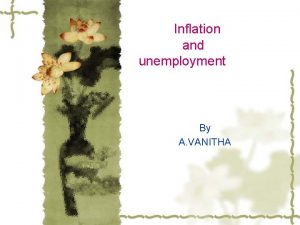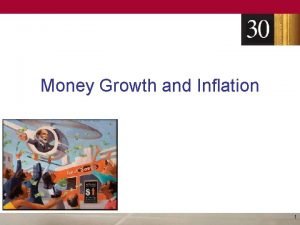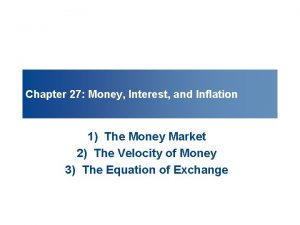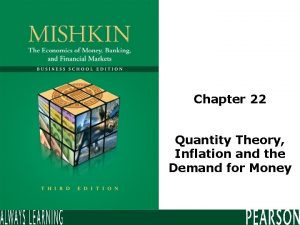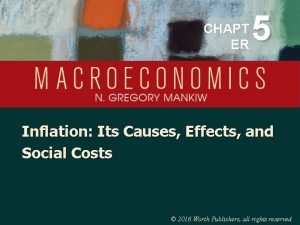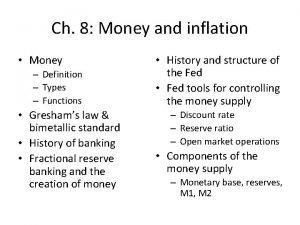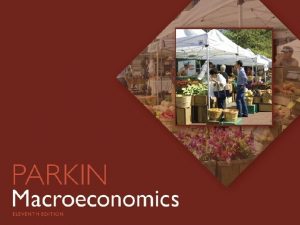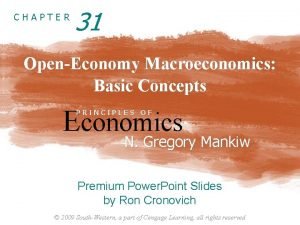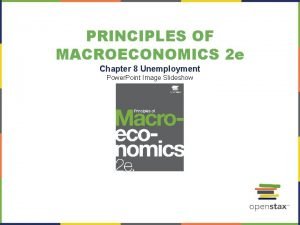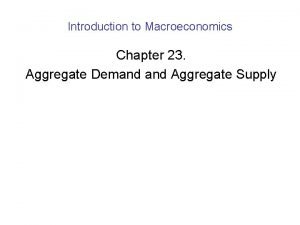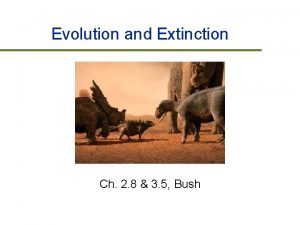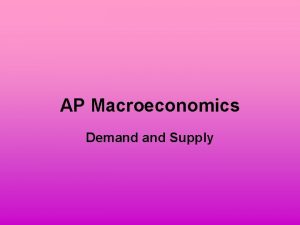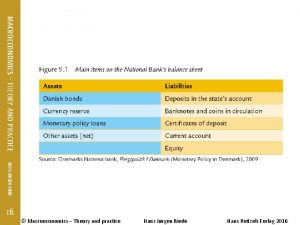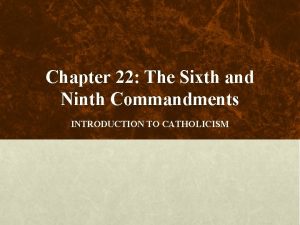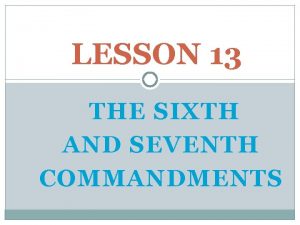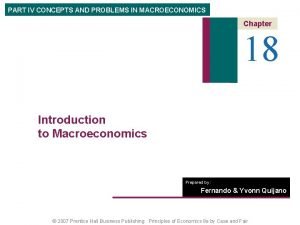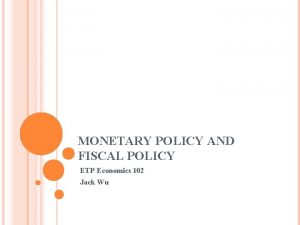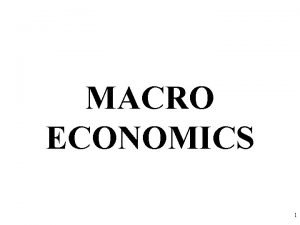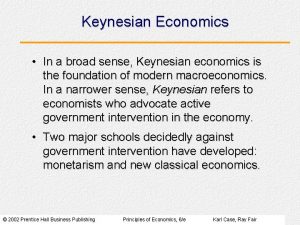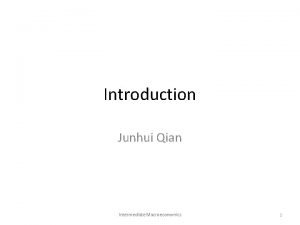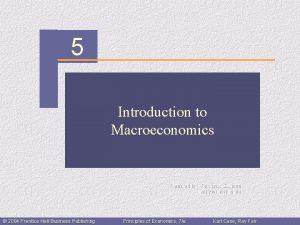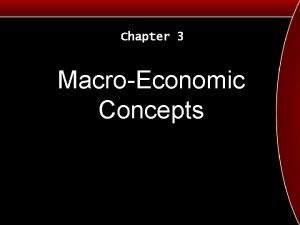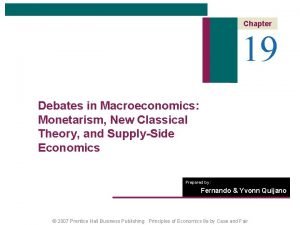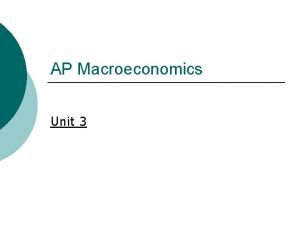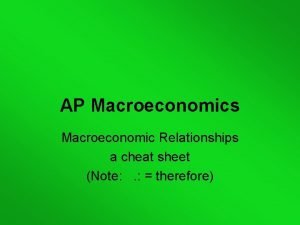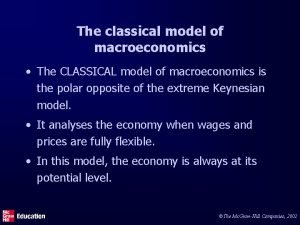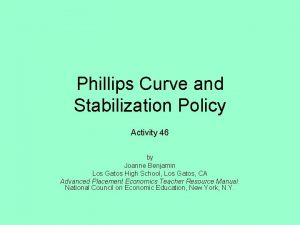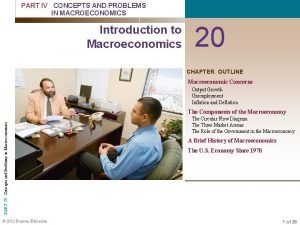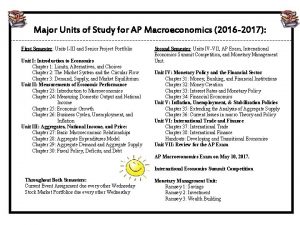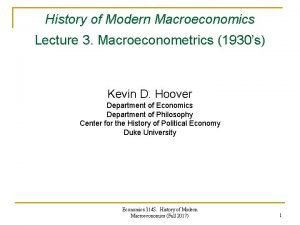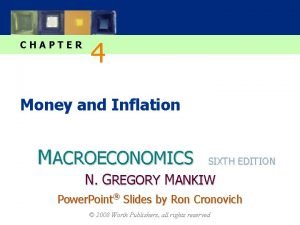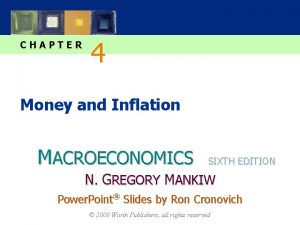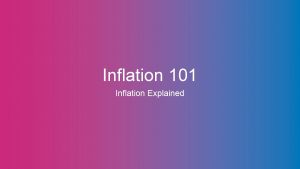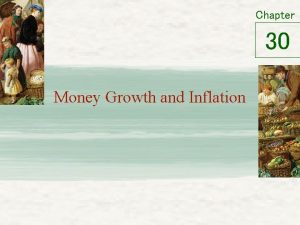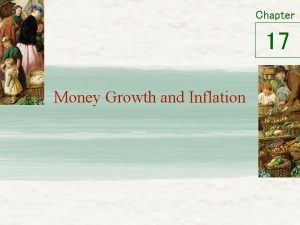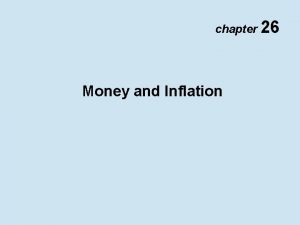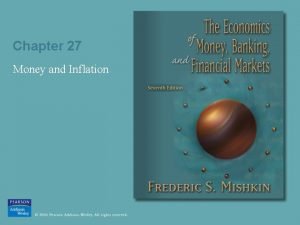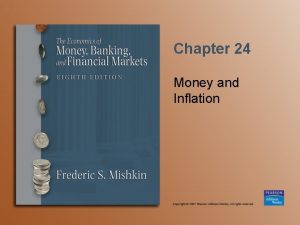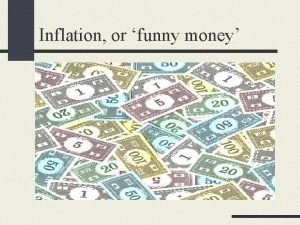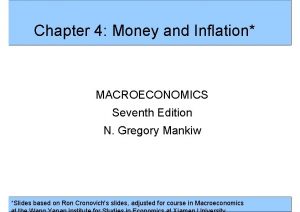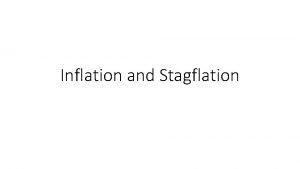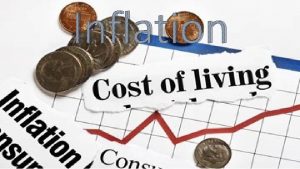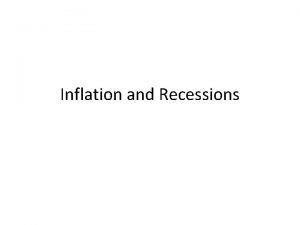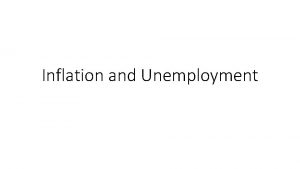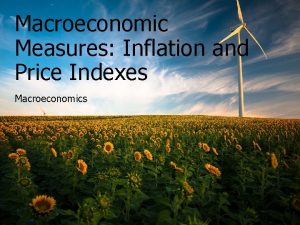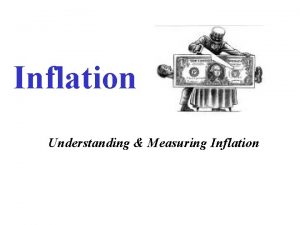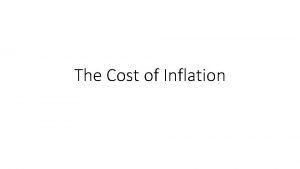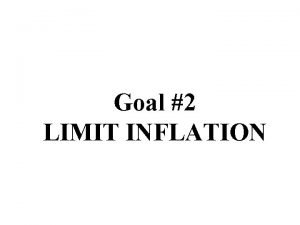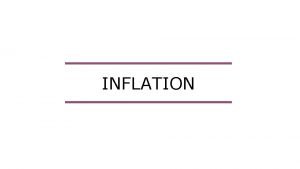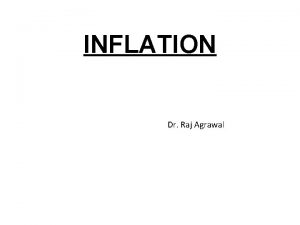CHAPTER 45 Money and Inflation MACROECONOMICS SIXTH EDITION



































































- Slides: 67

CHAPTER 4&5 Money and Inflation MACROECONOMICS SIXTH EDITION N. GREGORY MANKIW Power. Point® Slides by Ron Cronovich © 2008 Worth Publishers, all rights reserved

In this chapter, you will learn… § The classical theory of inflation § causes § effects § social costs § “Classical” – assumes prices are flexible & markets clear § Applies to the long run CHAPTER 4 Money and Inflation slide 1

U. S. inflation and its trend, 1960 -2007 15% % change in CPI from 12 months earlier 12% 9% long-run trend 6% 3% 0% 1960 1965 1970 1975 1980 1985 1990 1995 2000 2005 slide 2

The connection between money and prices § Inflation rate = the percentage increase in the average level of prices. § Price = amount of money required to buy a good. § Because prices are defined in terms of money, we need to consider the nature of money, the supply of money, and how it is controlled. CHAPTER 4 Money and Inflation slide 3

Money: Definition Money is the stock of assets that can be readily used to make transactions. CHAPTER 4 Money and Inflation slide 4

Money: Functions § medium of exchange we use it to buy stuff § store of value transfers purchasing power from the present to the future § unit of account the common unit by which everyone measures prices and values CHAPTER 4 Money and Inflation slide 5

Money: Types 1. fiat money § has no intrinsic value § example: the paper currency we use 2. commodity money § has intrinsic value § examples: gold coins, cigarettes in P. O. W. camps CHAPTER 4 Money and Inflation slide 6

Discussion Question Which of these are money? a. Currency b. Checks c. Deposits in checking accounts (“demand deposits”) d. Credit cards e. Certificates of deposit (“time deposits”) CHAPTER 4 Money and Inflation slide 7

The money supply and monetary policy definitions § The money supply is the quantity of money available in the economy. § Monetary policy is the control over the money supply. CHAPTER 4 Money and Inflation slide 8

The central bank § Monetary policy is conducted by a country’s central bank. § In the U. S. , the central bank is called the Federal Reserve (“the Fed”). The Federal Reserve Building Washington, DC CHAPTER 4 Money and Inflation slide 9

Money supply measures, May 2007 symbol assets included C amount ($ billions) Currency $755 M 1 C + demand deposits, travelers’ checks, other checkable deposits $1377 M 2 M 1 + small time deposits, savings deposits, money market mutual funds, money market deposit accounts $7227 CHAPTER 4 Money and Inflation slide 10

The Quantity Theory of Money § A simple theory linking the inflation rate to the growth rate of the money supply. § Begins with the concept of velocity… CHAPTER 4 Money and Inflation slide 11

Velocity § basic concept: the rate at which money circulates § definition: the number of times the average dollar bill changes hands in a given time period § example: In 2007, § $500 billion in transactions § money supply = $100 billion § The average dollar is used in five transactions in 2007 § So, velocity = 5 CHAPTER 4 Money and Inflation slide 12

Velocity, cont. § This suggests the following definition: where V = velocity T = value of all transactions M = money supply CHAPTER 4 Money and Inflation slide 13

Velocity, cont. § Use nominal GDP as a proxy for total transactions. Then, where P = price of output Y = quantity of output P Y = value of output CHAPTER 4 Money and Inflation (GDP deflator) (real GDP) (nominal GDP) slide 14

The quantity equation § The quantity equation M V = P Y follows from the preceding definition of velocity. § It is an identity: it holds by definition of the variables. CHAPTER 4 Money and Inflation slide 15

Money demand the quantity equation § M/P = real money balances, the purchasing power of the money supply. § A simple money demand function: (M/P )d = k Y where k = how much money people wish to hold for each dollar of income. (k is exogenous) CHAPTER 4 Money and Inflation slide 16

Money demand the quantity equation § § money demand: (M/P )d = k Y quantity equation: M V = P Y The connection between them: k = 1/V When people hold lots of money relative to their incomes (k is high), money changes hands infrequently (V is low). CHAPTER 4 Money and Inflation slide 17

Back to the quantity theory of money § starts with quantity equation § assumes V is constant & exogenous: § With this assumption, the quantity equation can be written as CHAPTER 4 Money and Inflation slide 18

The quantity theory of money, cont. How the price level is determined: § With V constant, the money supply determines nominal GDP (P Y ). § Real GDP is determined by the economy’s supplies of K and L and the production function (Chap 3). § The price level is P = (nominal GDP)/(real GDP). CHAPTER 4 Money and Inflation slide 19

The quantity theory of money, cont. § Recall from Chapter 2: The growth rate of a product equals the sum of the growth rates. § The quantity equation in growth rates: CHAPTER 4 Money and Inflation slide 20

The quantity theory of money, cont. (Greek letter “pi”) denotes the inflation rate: The result from the preceding slide was: Solve this result for to get CHAPTER 4 Money and Inflation slide 21

The quantity theory of money, cont. § Normal economic growth requires a certain amount of money supply growth to facilitate the growth in transactions. § Money growth in excess of this amount leads to inflation. CHAPTER 4 Money and Inflation slide 22

The quantity theory of money, cont. Y/Y depends on growth in the factors of production and on technological progress (all of which we take as given, for now). Hence, the Quantity Theory predicts a one-for-one relation between changes in the money growth rate and changes in the inflation rate. CHAPTER 4 Money and Inflation slide 23

Confronting the quantity theory with data The quantity theory of money implies 1. countries with higher money growth rates should have higher inflation rates. 2. the long-run trend behavior of a country’s inflation should be similar to the long-run trend in the country’s money growth rate. Are the data consistent with these implications? CHAPTER 4 Money and Inflation slide 24

International data on inflation and money growth Turkey Ecuador Indonesia Argentina U. S. Singapore CHAPTER 4 Money and Inflation Belarus Switzerland slide 25

U. S. inflation and money growth, 1960 -2007 15% 12% Over the long run, the inflation and money growth rates move together, as the quantity theory predicts. M 2 growth rate 9% 6% 3% inflation rate 0% 1960 1965 1970 1975 1980 1985 1990 1995 2000 2005 slide 26

Seigniorage § To spend more without raising taxes or selling bonds, the govt can print money. § The “revenue” raised from printing money is called seigniorage (pronounced SEEN-your-idge). § The inflation tax: Printing money to raise revenue causes inflation. Inflation is like a tax on people who hold money. CHAPTER 4 Money and Inflation slide 27

Inflation and interest rates § Nominal interest rate, i not adjusted for inflation § Real interest rate, r adjusted for inflation: r = i CHAPTER 4 Money and Inflation slide 28

The Fisher effect § The Fisher equation: i = r + § Chap 3: S = I determines r. § Hence, an increase in causes an equal increase in i. § This one-for-one relationship is called the Fisher effect. CHAPTER 4 Money and Inflation slide 29

percent per year Inflation and nominal interest rates in the U. S. , 1955 -2007 15% nominal interest rate 12% 9% 6% 3% 0% inflation rate -3% 1955 1960 1965 1970 1975 1980 1985 1990 1995 2000 2005 slide 30

Inflation and nominal interest rates across countries Romania Zimbabwe Brazil Bulgaria Israel Germany U. S. Switzerland CHAPTER 4 Money and Inflation slide 31

Exercise: Suppose V is constant, M is growing 5% per year, Y is growing 2% per year, and r = 4. a. Solve for i. b. If the Fed increases the money growth rate by 2 percentage points per year, find i. c. Suppose the growth rate of Y falls to 1% per year. § What will happen to ? § What must the Fed do if it wishes to keep constant? CHAPTER 4 Money and Inflation slide 32

Answers: V is constant, M grows 5% per year, Y grows 2% per year, r = 4. a. First, find = 5 2 = 3. Then, find i = r + = 4 + 3 = 7. b. i = 2, same as the increase in the money growth rate. c. If the Fed does nothing, = 1. To prevent inflation from rising, Fed must reduce the money growth rate by 1 percentage point per year. CHAPTER 4 Money and Inflation slide 33

Two real interest rates § = actual inflation rate (not known until after it has occurred) § e = expected inflation rate § i – e = ex ante real interest rate: the real interest rate people expect at the time they buy a bond or take out a loan § i – = ex post real interest rate: the real interest rate actually realized CHAPTER 4 Money and Inflation slide 34

Money demand the nominal interest rate § In the quantity theory of money, the demand for real money balances depends only on real income Y. § Another determinant of money demand: the nominal interest rate, i. § the opportunity cost of holding money (instead of bonds or other interest-earning assets). § Hence, i in money demand. CHAPTER 4 Money and Inflation slide 35

The money demand function (M/P )d = real money demand, depends § negatively on i i is the opp. cost of holding money § positively on Y higher Y more spending so, need more money (“L” is used for the money demand function because money is the most liquid asset. ) CHAPTER 4 Money and Inflation slide 36

The money demand function When people are deciding whether to hold money or bonds, they don’t know what inflation will turn out to be. Hence, the nominal interest rate relevant for money demand is r + e. CHAPTER 4 Money and Inflation slide 37

Equilibrium The supply of real money balances CHAPTER 4 Money and Inflation Real money demand slide 38

What determines what variable how determined (in the long run) M exogenous (the Fed) r adjusts to make S = I Y P CHAPTER 4 adjusts to make Money and Inflation slide 39

How P responds to M § For given values of r, Y, and e, a change in M causes P to change by the same percentage – just like in the quantity theory of money. CHAPTER 4 Money and Inflation slide 40

What about expected inflation? § Over the long run, people don’t consistently over- or under-forecast inflation, so e = on average. § In the short run, e may change when people get new information. § EX: Fed announces it will increase M next year. People will expect next year’s P to be higher, so e rises. § This affects P now, even though M hasn’t changed yet…. CHAPTER 4 Money and Inflation slide 41

How P responds to e § For given values of r, Y, and M , CHAPTER 4 Money and Inflation slide 42

Discussion question Why is inflation bad? § What costs does inflation impose on society? List all the ones you can think of. § Focus on the long run. § Think like an economist. CHAPTER 4 Money and Inflation slide 43

A common misperception § Common misperception: inflation reduces real wages § This is true only in the short run, when nominal wages are fixed by contracts. § (Chap. 3) In the long run, the real wage is determined by labor supply and the marginal product of labor, not the price level or inflation rate. § Consider the data… CHAPTER 4 Money and Inflation slide 44

Average hourly earnings and the CPI, 1964 -2007 $20 250 hourly wage $16 200 $14 $12 150 $10 $8 100 $6 CPI (right scale) $4 wage in current dollars $2 wage in 2007 dollars $0 CPI (1982 -84 = 100) $18 50 0 1965 1970 1975 1980 1985 1990 1995 2000 2005 slide 45

The classical view of inflation § The classical view: A change in the price level is merely a change in the units of measurement. So why, then, is inflation a social problem? CHAPTER 4 Money and Inflation slide 46

The social costs of inflation …fall into two categories: 1. costs when inflation is expected 2. costs when inflation is different than people had expected CHAPTER 4 Money and Inflation slide 47

The costs of expected inflation: 1. Shoeleather cost § def: the costs and inconveniences of reducing money balances to avoid the inflation tax. § i real money balances § Remember: In long run, inflation does not affect real income or real spending. § So, same monthly spending but lower average money holdings means more frequent trips to the bank to withdraw smaller amounts of cash. CHAPTER 4 Money and Inflation slide 48

The costs of expected inflation: 2. Menu costs § def: The costs of changing prices. § Examples: § cost of printing new menus § cost of printing & mailing new catalogs § The higher is inflation, the more frequently firms must change their prices and incur these costs. CHAPTER 4 Money and Inflation slide 49

The costs of expected inflation: 3. Relative price distortions § Firms facing menu costs change prices infrequently. § Example: A firm issues new catalog each January. As the general price level rises throughout the year, the firm’s relative price will fall. § Different firms change their prices at different times, leading to relative price distortions… …causing microeconomic inefficiencies in the allocation of resources. CHAPTER 4 Money and Inflation slide 50

The costs of expected inflation: 4. Unfair tax treatment Some taxes are not adjusted to account for inflation, such as the capital gains tax. Example: § Jan 1: you buy $10, 000 worth of IBM stock § Dec 31: you sell the stock for $11, 000, so your nominal capital gain is $1000 (10%). § Suppose = 10% during the year. Your real capital gain is $0. § But the govt requires you to pay taxes on your $1000 nominal gain!! CHAPTER 4 Money and Inflation slide 51

The costs of expected inflation: 5. General inconvenience § Inflation makes it harder to compare nominal values from different time periods. § This complicates long-range financial planning. CHAPTER 4 Money and Inflation slide 52

Additional cost of unexpected inflation: Arbitrary redistribution of purchasing power § Many long-term contracts not indexed, but based on e. § If turns out different from e, then some gain at others’ expense. Example: borrowers & lenders § If > e, then (i ) < (i e) and purchasing power is transferred from lenders to borrowers. § If < e, then purchasing power is transferred from borrowers to lenders. CHAPTER 4 Money and Inflation slide 53

Additional cost of high inflation: Increased uncertainty § When inflation is high, it’s more variable and unpredictable: turns out different from e more often, and the differences tend to be larger (though not systematically positive or negative) § Arbitrary redistributions of wealth become more likely. § This creates higher uncertainty, making risk averse people worse off. CHAPTER 4 Money and Inflation slide 54

One benefit of inflation § Nominal wages are rarely reduced, even when the equilibrium real wage falls. This hinders labor market clearing. § Inflation allows the real wages to reach equilibrium levels without nominal wage cuts. § Therefore, moderate inflation improves the functioning of labor markets. CHAPTER 4 Money and Inflation slide 55

Hyperinflation § def: 50% per month § All the costs of moderate inflation described above become HUGE under hyperinflation. § Money ceases to function as a store of value, and may not serve its other functions (unit of account, medium of exchange). § People may conduct transactions with barter or a stable foreign currency. CHAPTER 4 Money and Inflation slide 56

What causes hyperinflation? § Hyperinflation is caused by excessive money supply growth: § When the central bank prints money, the price level rises. § If it prints money rapidly enough, the result is hyperinflation. CHAPTER 4 Money and Inflation slide 57

A few examples of hyperinflation money growth (%) inflation (%) Israel, 1983 -85 295 275 Poland, 1989 -90 344 400 Brazil, 1987 -94 1350 1323 Argentina, 1988 -90 1264 1912 Peru, 1988 -90 2974 3849 Nicaragua, 1987 -91 4991 5261 Bolivia, 1984 -85 4208 6515 CHAPTER 4 Money and Inflation slide 58

Why governments create hyperinflation § When a government cannot raise taxes or sell bonds, it must finance spending increases by printing money. § In theory, the solution to hyperinflation is simple: stop printing money. § In the real world, this requires drastic and painful fiscal restraint. CHAPTER 4 Money and Inflation slide 59

The Classical Dichotomy Real variables: Measured in physical units – quantities and relative prices, for example: § quantity of output. Measured produced in money units, e. g. , Nominal variables: real wage: output earned of work §§nominal wage: Dollars per hour of work. real interest rate: output earned in the §§nominal interest rate: Dollars earned in future bylendingone onedollar unit oftoday. output today by § the price level: The amount of dollars needed to buy a representative basket of goods. CHAPTER 4 Money and Inflation slide 60

The Classical Dichotomy § Note: Real variables were explained in Chap 3, nominal ones in Chapter 4. § Classical dichotomy: theoretical separation of real and nominal variables in the classical model, which implies nominal variables do not affect real variables. § Neutrality of money: Changes in the money supply do not affect real variables. In the real world, money is approximately neutral in the long run. CHAPTER 4 Money and Inflation slide 61

Chapter Summary Money § the stock of assets used for transactions § serves as a medium of exchange, store of value, and unit of account. § Commodity money has intrinsic value, fiat money does not. § Central bank controls the money supply. Quantity theory of money assumes velocity is stable, concludes that the money growth rate determines the inflation rate. CHAPTER 4 Money and Inflation slide 62

Chapter Summary Nominal interest rate § equals real interest rate + inflation rate § the opp. cost of holding money § Fisher effect: Nominal interest rate moves one-for-one w/ expected inflation. Money demand § depends only on income in the Quantity Theory § also depends on the nominal interest rate § if so, then changes in expected inflation affect the current price level. CHAPTER 4 Money and Inflation slide 63

Chapter Summary Costs of inflation § Expected inflation shoeleather costs, menu costs, tax & relative price distortions, inconvenience of correcting figures for inflation § Unexpected inflation all of the above plus arbitrary redistributions of wealth between debtors and creditors CHAPTER 4 Money and Inflation slide 64

Chapter Summary Hyperinflation § caused by rapid money supply growth when money printed to finance govt budget deficits § stopping it requires fiscal reforms to eliminate govt’s need for printing money CHAPTER 4 Money and Inflation slide 65

Chapter Summary Classical dichotomy § In classical theory, money is neutral--does not affect real variables. § So, we can study how real variables are determined w/o reference to nominal ones. § Then, money market eq’m determines price level and all nominal variables. § Most economists believe the economy works this way in the long run. CHAPTER 4 Money and Inflation slide 66
 Peter pickle tongue twister
Peter pickle tongue twister Rubber baby buggy bumpers tongue twister lyrics
Rubber baby buggy bumpers tongue twister lyrics Dana damian
Dana damian Money growth formula
Money growth formula Introduction of inflation
Introduction of inflation Biochemistry sixth edition
Biochemistry sixth edition Macroeconomics michael parkin 13th edition
Macroeconomics michael parkin 13th edition Macroeconomics
Macroeconomics Computer architecture a quantitative approach sixth edition
Computer architecture a quantitative approach sixth edition Automotive technology sixth edition
Automotive technology sixth edition Automotive technology sixth edition
Automotive technology sixth edition Apa sixth edition
Apa sixth edition Computer architecture a quantitative approach 6th
Computer architecture a quantitative approach 6th Precalculus sixth edition
Precalculus sixth edition Principles of economics sixth edition
Principles of economics sixth edition Computer architecture a quantitative approach sixth edition
Computer architecture a quantitative approach sixth edition Quantity theory of money inflation
Quantity theory of money inflation Velocity of money
Velocity of money Quantity theory of money equation
Quantity theory of money equation Hyperinflation examples
Hyperinflation examples 8 money types
8 money types Quantity theory of money inflation
Quantity theory of money inflation Chapter 31 open economy macroeconomics
Chapter 31 open economy macroeconomics Macroeconomics chapter 7
Macroeconomics chapter 7 Macroeconomics chapter 8
Macroeconomics chapter 8 Vertical supply curve
Vertical supply curve Using mis (10th edition) 10th edition
Using mis (10th edition) 10th edition Report
Report Tom buchanan symbolism
Tom buchanan symbolism Money smart money match
Money smart money match Money on money multiple
Money on money multiple Context of great gatsby
Context of great gatsby Tom buchanan character traits
Tom buchanan character traits Modes of speciation ppt
Modes of speciation ppt Venn diagram of microeconomics and macroeconomics
Venn diagram of microeconomics and macroeconomics What is macroeconomics
What is macroeconomics New classical and new keynesian macroeconomics
New classical and new keynesian macroeconomics Nicepp
Nicepp Macroeconomics theory and practice
Macroeconomics theory and practice New classical and new keynesian macroeconomics
New classical and new keynesian macroeconomics 6th and 9th commandments
6th and 9th commandments The sixth and ninth commandments
The sixth and ninth commandments The fifth, sixth, seventh, and eighth amendments protect *
The fifth, sixth, seventh, and eighth amendments protect * 7th commandment worksheet
7th commandment worksheet Transfer payments
Transfer payments Macroeconomics
Macroeconomics Crowding out effect macroeconomics
Crowding out effect macroeconomics Crowding out effect macroeconomics
Crowding out effect macroeconomics Expansionary fiscal policy graph
Expansionary fiscal policy graph Meaning of managerial economics
Meaning of managerial economics What is the theory of liquidity preference
What is the theory of liquidity preference Real gdp formula macroeconomics
Real gdp formula macroeconomics New classical macroeconomics
New classical macroeconomics New classical macroeconomics
New classical macroeconomics Crowding out
Crowding out 2012 macroeconomics frq
2012 macroeconomics frq Expanded circular flow diagram
Expanded circular flow diagram Ap macroeconomics-percentage for a 5
Ap macroeconomics-percentage for a 5 Macroeconomics deals with
Macroeconomics deals with Supply side economics
Supply side economics Ap macroeconomics unit 3
Ap macroeconomics unit 3 Ap macroeconomics cheat sheet
Ap macroeconomics cheat sheet Ap macro graphs
Ap macro graphs Macroeconomics
Macroeconomics Aw phillips curve
Aw phillips curve The components of macroeconomics
The components of macroeconomics Ap macroeconomics frq 2016
Ap macroeconomics frq 2016 Founder of macroeconomics
Founder of macroeconomics




